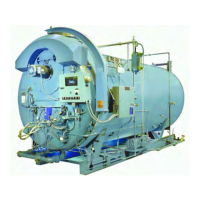Chapter 2 — Burner Operation and Control
2-4 Part No. 750-184
B. CONTROL AND COMPONENT FUNCTION
The term “control” covers the more important valves and
components, including but not limited to electrical controls or those
monitored by the program relay. The operator must become familiar
with the individual functioning of all controls before understanding
boiler operation and procedures outlined in this manual.
The actual controls furnished with any given boiler will depend upon
the type of fuel for which it is equipped, and whether it is a hot
water or steam boiler. Refer to the applicable group or groups within
Chapter 2 that apply to the particular boiler.
Boilers with optional features may have control components not
listed here.
C. COMPONENTS COMMON TO ALL BOILERS
1. Forced Draft Fan Motor (Figure 2-5): Drives the forced draft fan
directly to provide combustion air. Also referred to as a blower
motor.
2. Forced Draft Fan (Figure 2-6): Provides all air, under pressure, for
combustion of pilot fuel and main fuel, and for purging.
3. Modulating Motor (Figure 2-6): Operates the rotary air damper
and fuel metering valves through a cam and linkage system to
provide proper air/fuel ratios under all boiler load conditions.
4. Modulating Motor Transformer (located in the mod motor):
Reduces control circuit voltage (115 Vac) to required voltage
(24Vac) for operation of the modulating motor.
5. Forced Draft Fan Motor Starter (Figure 2-9 & 2-10): Energizes
forced draft fan (blower) motor.
6. Ignition Transformer: Provides high voltage spark for ignition of
gas pilot or light oil pilot.
7. Low Fire Switch (located in mod motor): An internal auxiliary
switch, cam actuated by the motor shaft, which must be closed
to indicate that the air damper and fuel metering valve are in the
low fire position before an ignition cycle can occur.
8. Atomizing Air Proving Switch: A pressure-sensitive switch
actuated by air pressure from the Air Pump. Its contacts close to
prove presence of atomizing air. The fuel valves cannot be
energized unless this switch is satisfied.
9. Manual-Automatic Switch (Figure 2-8): When set at
“automatic,” subsequent operation is at the command of the
modulating control, which governs the position of the modulating
motor in accordance with load demand. When set at “manual,”
the modulating motor, through the manual flame control, can be
positioned at a desired burner firing rate. The primary purpose of
the manual position is for testing and setting the air/fuel ratio
through the entire firing range.
10.Manual Flame Control (Figure 2-8): A manually operated
potentiometer that permits the positioning of the modulating
motor to a desired burner firing rate when the manual-automatic
switch is set on “manual“. It is used primarily for initial or
Figure 2-3 Fan Motor
Figure 2-4 Fan
Figure 2-5 Mod Motor

